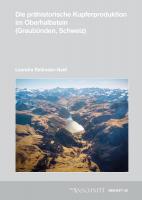Die prähistorische Kupferproduktion im Oberhalbstein (Graubünden, Schweiz)
Keywords:
mining archaeology, copper metallurgy, Late Bronze Age, Early Iron Age, Central AlpsSynopsis
The inner Alpine Oberhalbstein valley has long been known as a Bronze Age settlement chamber and prehistoric mining landscape. Systematic mining-archaeological investigations have now brought to light several prehistoric mines and almost 90 smelting sites. Extensive series of absolute dates suggest that copper production occurred in two main phases: a Late Bronze Age phase (11th century BC) and an Early Iron Age phase (7th century BC). In addition to the summary presentation of the mining archaeological findings, the present study puts a special focus on the detailed decoding of the processing technology. Based on typological, morphological and archaeometric investigations of smelting slag as well as ore analyses, the process chain is traced, from the mining of the ore via the processing, only traces of which are known as of yet, to the smelting. The publication contains an extensive appendix of research data.
The Open Access version of this publication is published with the support of the Schweizerischer Nationalfonds zur Förderung der wissenschaftlichen Forschung.
Funding no.: 10BP12_206259





